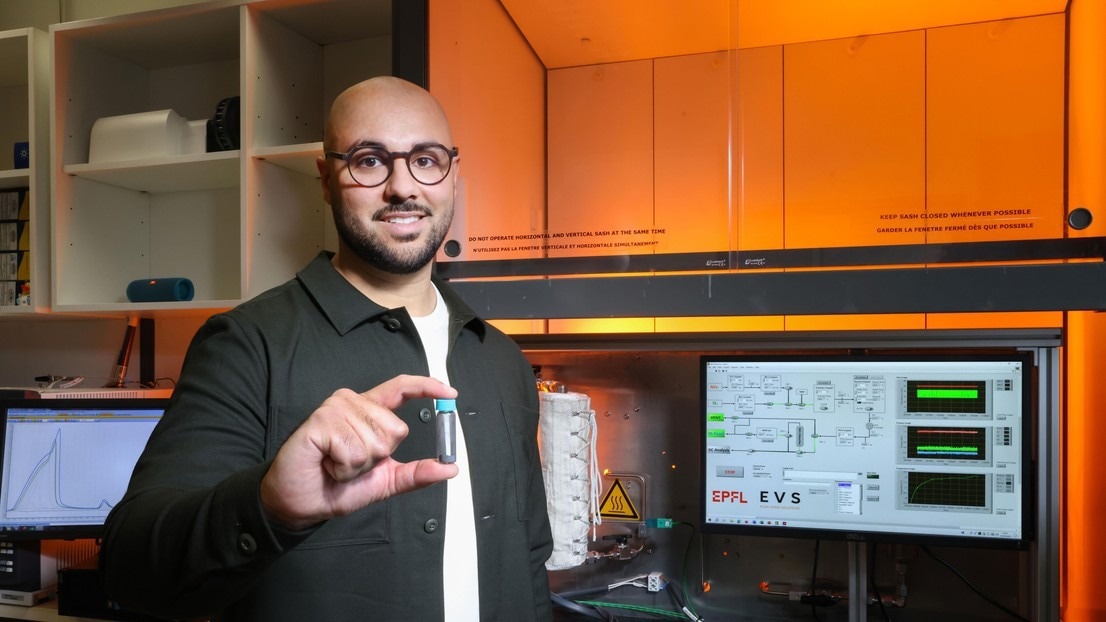Kevin Turani-I-Belloto has created an inexpensive technique for converting ammonia to hydrogen and has received funding from Bridge to create a proof of concept for his invention.
 Kevin Turani-I-Belloto has developed a low-cost method for breaking down ammonia to produce hydrogen. Image Credit: 2024 EPFL/Alain Herzog - CC-BY-SA 4.0
Kevin Turani-I-Belloto has developed a low-cost method for breaking down ammonia to produce hydrogen. Image Credit: 2024 EPFL/Alain Herzog - CC-BY-SA 4.0
Without hydrogen, Kevin Turani-I-Belloto most likely would not have arrived at EPFL, let alone selected hydrogen storage as the subject of his Ph.D. thesis. However, NH3, a mixture of hydrogen and nitrogen, which is related to hydrogen, is what is occupying him these days.
Turani-I-Belloto, an associate researcher in Prof. Oliver Kröcher’s Catalysis for Biofuels research group at EPFL, has created a catalyst that can degrade ammonia more cheaply and without the need for rare-earth metals than current techniques.
He was given funding to help develop a prototype last fall: an Enable grant from EPFL's Technology Transfer Office and an Ignition award from the Vice Presidency for Innovation at EPFL. He has now been chosen for a Bridge Proof of Concept award, which is being provided by Innosuisse and the Swiss National Science Foundation as part of a collaborative effort.
Hydrogen has the potential to be utilized as fuel and as a means of storing excess energy from renewable sources. Being the smallest molecule in the universe, it can pass through even the smallest opening. The extremely low density necessitates storage at a temperature of –252 °C for liquid form or 350 or 700 bars for gas use, depending on the norm.
Hydrogen distribution networks are still costly since they are hard to come by. Though producing these chemicals is not very energy-efficient, operators of ships and airplanes—vehicles for which electric batteries are not currently practical—are putting their money on hydrogen or synthetic fuels derived from hydrogen.
A Secret Formula
This is where the novel approach of Turani-I-Belloto is useful. He suggests moving hydrogen using ammonia.
Today, half of the hydrogen that’s produced goes to the manufacture of ammonia, which in turn is used as the main ingredient in fertilizer.
Turani-I-Belloto, Associate Professor, EPFL
Although ammonia gas does not have a color, it has a slight odor so leaks can be found easily. It is a viable option for transportation since it can liquefy at a respectable temperature of –33 °C and a comparatively low pressure of 8.5 bars. Moreover, liquid hydrogen has a lower energy density than liquid ammonia.
“What is more, distribution networks for ammonia are already well-developed around the world,” Turani-I-Belloto added.
He further added, “Hence my idea for using it to transport hydrogen. What I want to do is leverage the benefits of each gas: ammonia for transport and hydrogen for energy, producing it from ammonia right where it is needed. That will make it possible to meet demand for clean energy, both for cargo vehicles and in an array of other industries.”
Ammonia must be converted to hydrogen via a catalyst.
Turani-I-Belloto added, “Catalyzing agents do exist, but they’re either not effective enough or they are too expensive, like ruthenium, an extremely rare metal. My system delivers high yields, uses abundant raw materials and cuts the catalyst cost by a factor of over 200.”
Funding organizations definitely see potential in Turani-I-Belloto’s technique, albeit he keeps the specifics of his approach hidden.
He noted, “It is my magic formula.”
As a result, there is no way to see inside the black box. However, his small demonstrator is now installed in the research group’s laboratory, demonstrating the potential of his novel catalyst. He applied for a patent for his innovation.
“If we are successful in using ammonia to store hydrogen, that will unlock an entire value chain,” Turani-I-Belloto concluded.